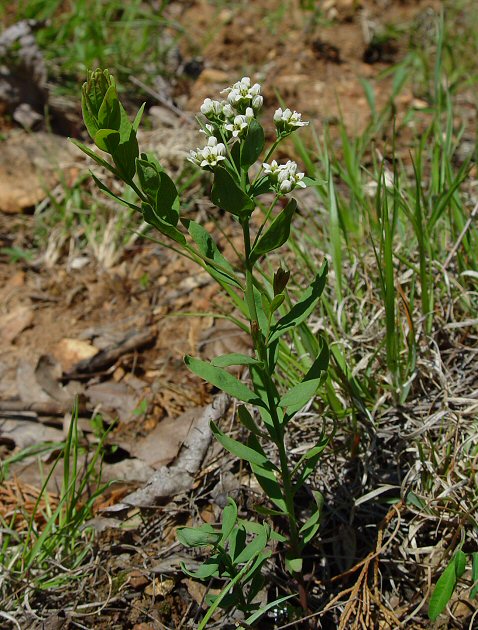Comandra umbellata (L.) Nutt.
Bastard Toadflax

Native
CC = 7
CW = 5
MOC = 66
© DETenaglia
Comandra umbellata (L.) Nutt.Bastard Toadflax | |
 |
Native CC = 7 CW = 5 MOC = 66 |
© DETenaglia |
|
Family - Santalaceae Habit - Perennial forb, parasitic, with extensive network of deeply set rhizomes. Stems - Ascending to erect, to 25 cm, simple to branching, glabrous.
Leaves - Alternate, simple, sessile or very short petiolate, entire, glabrous, variously oblanceolate to ovate, tapered at the base, narrowed to a pointed tip, to 0.7-5.0 cm long, 1 cm broad.
Inflorescence - Dense, roughly umbellate clusters of flowers axillary in the uppermost leaves, these short-stalked, the whole inflorescence thus appearing as a leafy panicle, or paniculate, terminal clusters of 4-6 flowered cymules. Pedicels 1-4 mm long, glabrous.
Flowers - Perfect, epigynous, actinomorphic, the hypanthium 2-3 mm long, narrowly bell-shaped to obconical, with a prominent shallowly lobed nectary on the inner surface, glabrous. Sepals 5, 2-3 mm long, oblong-lanceolate to narrowly ovate, white, persistent at fruiting, usually minutely hairy on the upper surface and with a small tuft of longer hairs at the base, these hairs more or less fused with the adjacent anther. Petals absent. Stamens 5, attached opposite the sepals along the hypanthium rim, the filaments short, the anthers yellow. Pistil 1 per flower, usually of 3 fused carpels. Ovary inferior, 1-locular, the placentation free-central, with 2-3 ovules. Style 1, the stigma capitate.
Fruits - Nearly spherical 1-seeded drupes, 4-6 mm in diameter, dark brown at maturity.
Flowering - May - July. Habitat - Upland woods and prairies, bluff tops, glades. Origin - Native to the U.S. Lookalikes - None. Other info. - This little plant is fairly common in dry, relatively undisturbed areas throughout Missouri, and is found across most of the upper Midwest and New England states. It is easily recognized in these habitats by its tight clusters of white flowers, leafy stems, and diminutive size. It is parasitic on neighboring plants by means of its rhizomes, which are tan, thin, and fairly long. Photographs taken at Whetstone Conservation Area, Callaway County, MO., 4-26-04 (DETenaglia); also at Young Conservation Area, Jefferson County, MO, 5-2-2013, Chiracahua National Monument, Cochise County, AZ, 5-26-2016, and St. Joe State Park, St. Francois County, MO, 4-5-2024 (SRTurner). |